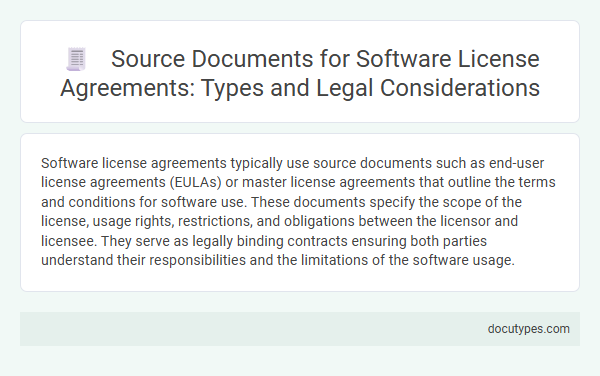Software license agreements typically use source documents such as end-user license agreements (EULAs) or master license agreements that outline the terms and conditions for software use. These documents specify the scope of the license, usage rights, restrictions, and obligations between the licensor and licensee. They serve as legally binding contracts ensuring both parties understand their responsibilities and the limitations of the software usage.
Introduction to Software License Agreements
Software license agreements define the terms under which software can be used, distributed, or modified. These agreements are crucial for protecting intellectual property rights and outlining user responsibilities. The primary source document used is the software license agreement itself, which specifies permissions, restrictions, and liabilities.
Importance of Source Documents in Licensing
Source documents for software license agreements typically include the original licensing contract, end-user license agreements (EULAs), and software development records. These documents serve as the foundational reference for defining the scope, terms, and conditions of software usage rights.
Source documents are crucial in licensing because they establish legal boundaries and protect intellectual property rights. They provide clear evidence of the agreed-upon terms between licensors and licensees, minimizing disputes. Accurate source documents ensure compliance with regulatory requirements and facilitate effective software management.
Common Types of Source Documents
| Source Document Type | Description | Purpose in Software License Agreements |
|---|---|---|
| Master License Agreement (MLA) | A comprehensive document outlining general terms and conditions for software licensing between parties. | Defines rights, obligations, usage limits, payment terms, and renewal conditions. |
| End User License Agreement (EULA) | A legal contract between the software licensor and the end user specifying permitted uses. | Restricts usage rights, protects intellectual property, and sets liability limits for end users. |
| Software Subscription Agreement | Contract covering the terms for subscription-based software services, including SaaS models. | Details subscription fees, access rights, service levels, and support obligations. |
| Grant of License Document | Explicit statement granting a license for software use under specified conditions. | Formalizes the licensed software scope, duration, and usage restrictions. |
| Purchase Order (PO) | Administrative document issued by the licensee to confirm the acquisition of software licenses. | Serves as evidence of purchase and links to primary license agreement terms. |
| Amendments and Addendums | Supplemental documents modifying terms of an existing software license agreement. | Update license scope, pricing, or duration without drafting a new agreement. |
Master Service Agreements (MSA)
Software license agreements often rely on Master Service Agreements (MSA) as the primary source document. MSAs define the overarching terms and conditions that govern the relationship between software vendors and clients.
The MSA streamlines future software license agreements by providing a standardized legal framework. Your software licensing terms are typically detailed under this master contract to ensure consistency and clarity.
End-User License Agreements (EULA)
Software license agreements are formal contracts governing the use and distribution of software. End-User License Agreements (EULA) are the most common source documents used for these agreements, specifying the rights and restrictions for the software user.
- Legal Framework - EULAs establish the legally binding terms under which end users may install, access, and utilize software applications.
- Scope of License - They define the type of license granted, such as single-user, multi-user, or subscription-based access, outlining permitted usage conditions.
- Limitation and Liability - EULAs include clauses regarding liability limitations, warranties, and dispute resolution to protect software vendors from legal risks.
Statements of Work (SOW) and Annexures
Software License Agreements often incorporate specific source documents to define the scope and details of the services provided. Statements of Work (SOW) and Annexures serve as critical components in outlining responsibilities and technical specifications.
- Statements of Work (SOW) - Detailed documents that specify project deliverables, timelines, and client obligations within the software license context.
- Annexures - Supplementary attachments that include technical details, legal terms, or pricing schedules related to the main license agreement.
- Source Document Purpose - Both SOWs and Annexures ensure clarity and reduce ambiguity in software licensing by providing structured, project-specific information.
These source documents enhance the enforceability and precision of Software License Agreements.
Third-Party Software and Open Source Licenses
What type of source document is used for software license agreements involving third-party software and open source licenses? Software license agreements for third-party software often rely on End User License Agreements (EULAs) or OEM licenses, which specify usage rights and restrictions. Open source licenses use standardized documents like the MIT License, GPL, and Apache License to govern terms transparently and ensure compliance.
How do these source documents impact your software development process? Understanding and adhering to the specific license terms in these source documents is crucial to avoid legal risks and maintain proper usage rights within your software products. Clear documentation helps streamline compliance and integrates smoothly with your development lifecycle.
Key Legal Considerations for Source Documents
Software license agreements typically originate from formal source documents such as Master Service Agreements (MSAs), End User License Agreements (EULAs), or customized contract templates. These documents establish the terms governing the use, distribution, and restrictions of software products.
Key legal considerations for these source documents include clear definitions of intellectual property rights, scope of license, and limitations of liability. You must ensure compliance with jurisdiction-specific regulations and include provisions for dispute resolution and termination conditions.
Best Practices for Drafting and Retaining Source Documents
Source documents for software license agreements typically include the master agreement, amendments, and related correspondence. Proper drafting and retention of these documents ensure legal clarity and facilitate future reference.
- Master Agreement - The primary source document outlining the terms, conditions, and scope of the software license.
- Amendments and Addendums - Documents that modify or expand the original agreement to reflect changes or additional provisions.
- Retention Best Practices - Maintain organized, accessible digital and physical copies with clear version control to preserve document integrity.
What Type of Source Document Is Used for Software License Agreements? Infographic

